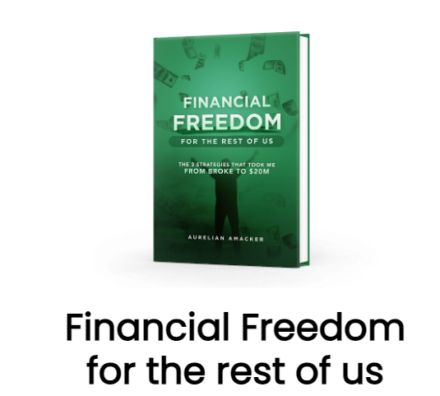Ben Feys and Kevin Niehoff had a problem.
As young professionals working busy day jobs, they struggled with skincare issues like acne and eczema but couldn’t find products that worked for them.
Rather than accept their fate, these best friends decided to take matters into their own hands. They dreamed of creating the “Nike of skincare” — a brand built specifically for active males like themselves.
In 2019, Ben and Kevin finally decided to scratch their entrepreneurial itch and turn this passion project into a side hustle reality.
Little did they know their bootstrapped men’s skincare line YoPrettyBoy.com would be on track to generate over $1 million in annual revenue just a few years later.
Tune into Episode 581 of The Side Hustle Show to learn:
How Kevin and Ben validated the market opportunity for PrettyBoy
The extensive research and preparations that went into formulating and launching their products
Clever branding and positioning strategies to stand out in a crowded market
Traction tactics to efficiently acquire customers and drive repeat sales
Key operational areas like manufacturing, fulfillment, and inventory management
25 E-Commerce Niche Ideas
Find profitable products with these categories.
Enter your email to grab the free resource now:
You’ll also receive my best side hustle tips and weekly-ish newsletter. Opt-out anytime.
Finding the Idea and Early Inspiration
The skincare market already had countless products from huge brands. So what made Kevin and Ben think they could compete?
As Kevin explains, “Ben and I have been going to dermatologists for over 10 years. We’ve been using products that haven’t really been what we really wanted out of skincare.”
Both founders had struggled with skincare issues since their teenage years. They had tried products from the biggest brands out there but never found something that fully met their needs and preferences as male consumers.
Ben added, “When I was younger I had kind of the acne-prone skin breakouts [and] was super self conscious about it.”
This inspired them to consider — what if they could develop a skincare line fully optimized for how men want to take care of their skin?
Extensive Pre-Launch Market Research
Ben and Kevin knew that launching a skincare brand in an already crowded market wouldn’t be easy.
“There are dozens of skincare products out there, including some from huge brands,” says Ben. “We asked ourselves, what’s going through your head? Can we really compete with the big guys?”
Rather than get discouraged, the duo leaned into the competition. As former athletes, Ben and Kevin have a competitive drive baked into their DNA.
“Innovation is best fostered through competition,” says Ben. “We knew if we could be unique enough and solve key pain points, we could break into the market.”
To find those pain points, Ben and Kevin went straight to the source: hundreds of potential male customers. Their 30-question survey uncovered some clear preferences:
Simplicity – Men wanted streamlined routines with fewer products.
Performance – Their top concern was products that actually work.
Texture – Heavy creams and greasy formulas were dealbreakers.
“So many brands were coming out with five-step routines or more,” says Kevin. “But the data showed most guys don’t want to use more than three products.”
But they didn’t stop there. To build credibility, they had dermatologists evaluate the ingredients list for their product versus competitors. As Ben shares, “We did clinical surveys where we were asking hundreds of dermatologists to rank our ingredient list against name brand competitors.”
They also estimated the total addressable market (TAM) for men’s skincare products to be massive.
Armed with these insights, Ben and Kevin finally felt confident they could compete in skincare—with the right branding and positioning.
Finding the Right Manufacturer
Turning survey feedback into an actual product still posed challenges. Kevin admits, “We didn’t know what the hell we were doing early on. We were using Google. We were calling manufacturers, just trying to get on the phone, calling people in China. And it was pretty stressful.”
After months of calls and dead ends, they finally connected with a US-based contract manufacturer via a networking connection (Kevin’s girlfriend).
This manufacturer had experience developing products for major brands and could handle sourcing ingredients, formulating products, compliance testing, and production.
The minimum order was daunting at 10,000 units and nearly $70,000. But Kevin and Ben saw it as go big or go home.
As Kevin explained, “If we’re going all in on this, it’s got to work and it’s going to work.”
Developing the Brand Identity
With the product development underway, Kevin and Ben turned their focus to branding. They wanted to create an identity that would stand out in a sea of clinical, masculine skincare brands.
As a former football player, Kevin wasn’t always flattered by the “pretty boy” moniker.
He explains, “Now we all work out, eat healthy, want to look our best, type of thing. And you said, am I the OG pretty boy in the earlier call? Like my football coach in high school used to call me a pretty boy for one. You wear the visor, the towel, look good, feel good, play good.”
But they decided to reclaim the term to reflect their positioning.
This mentality of embracing your appearance aligned well with their target demographic. And it allowed them to have fun building out the brand aesthetic across the website, packaging, and content.
Gaining Those First Sales and Initial Traction
In mid-2021, the first 10,000 unit production run arrived at Kevin and Ben’s doorstep. Now the real work began—selling to real customers.
Their initial sales came from friends, family, and early supporters who had provided feedback. But word of mouth alone wouldn’t scale the business.
For broader customer acquisition, Facebook ads were crucial. Kevin suggests simple video ads talking to the camera about the product. They aim for cost per purchase in the mid $20s based on the $70-80 customer lifetime value.
TikTok ads were another channel they tried but learned to focus ad spend on just one platform. As Kevin advises, “Don’t try to do too many things. Stick with one, become a master of it.”
Driving organic traffic through SEO blog content has been big too. Targeting informative keywords can attract potential customers.
Lead generation tactics like offering 15% off in exchange for an email also helped capture interested website visitors.
Podcasts like Andrew Faris’ e-commerce show provided guidance on strategies to drive sales.
With a solid product and savvy marketing, PrettyBoy gained traction beyond just friends and family.
Their sales funnel and customer base expanded steadily.
Leveraging Tools and Technology
PrettyBoy leveraged various tools and technologies to streamline operations:
3PL: They upgraded to a 3rd party logistics provider for $3-3.50 per order. This freed up time for higher-level tasks.
UGC: User-generated content was more affordable than influencers.
Facebook Ads Library: Researching other top brands’ ads provided inspiration for their own ad creative.
ChatGPT – An AI that writes SEO-optimized articles that attract and inform potential customers.
Shopify – They offer a subscription option on their Shopify store. Around 60% of monthly sales now come from subscribers.
Amazon – Most product searches now begin on Amazon, which provides incredible visibility.
A Day in Their Life and Lessons Learned
During the early days, Kevin and Ben handled everything from packing orders to customer service. This gave them a hands-on understanding of the business.
Inventory management and cash flow projections were challenges they improved over time through financial modeling and forecasting. Managing an external 3PL partner also brought new lessons.
But overall, staying lean and reinvesting revenue served them well in scaling up efficiently.
What’s Next?
With strong momentum, the PrettyBoy team is excited about the future. They aim to continue exceeding sales targets through strategies like expanded Amazon distribution.
Crossing $1 million in annual revenue is within reach. And they’re getting close to being able to pursue the business full-time.
There’s still plenty of room to grow by optimizing digital marketing and expanding globally in the years ahead.
Key Takeaways for Aspiring Entrepreneurs
Kevin and Ben’s success building PrettyBoy as a side hustle offers inspirational lessons for other aspiring entrepreneurs:
Do your homework through extensive market research before and after launch.
Reinvest revenue to aggressively grow instead of taking profits too early.
Think big about the total addressable market and your potential niche.
Kevin and Ben’s #1 Side Hustle Tips
Kevin: “Get a co-founder, stay lean.”
Ben: “Be customer-obsessed, get 1% better every day.”
25 E-Commerce Niche Ideas
Find profitable products with these categories.
Enter your email to grab the free resource now:
You’ll also receive my best side hustle tips and weekly-ish newsletter. Opt-out anytime.
Links and Resources from this Episode
Ben Feys
Kevin Niehoff
YoPrettyBoy
Andrew Faris’ e-commerce show
ChatGPT
Shopify
Amazon
Looking for More Side Hustle Help?
Start Your Free $500 Challenge. My free 5-day email course shows you how to add $500 to your bottom line.
Join the free Side Hustle Nation Community. The free Facebook group is the best place to connect with other side hustlers and get your questions answered.
Download The Side Hustle Show. My free podcast shares how to make extra money with actionable weekly episodes.


















